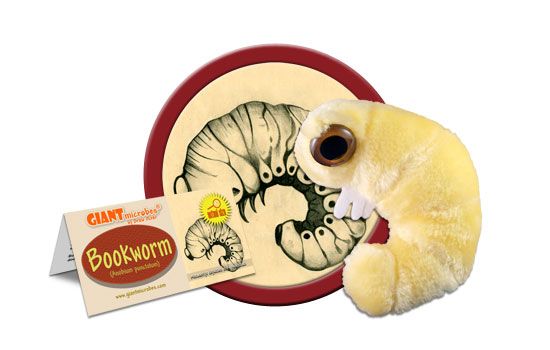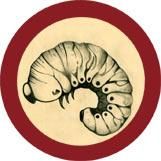Bookworm (Anobium punctatum)
Product Details
Additional Information
| Sizes | Giantmicrobes are based on actual microbes, cells, organisms and other critters, only 1,000,000 times actual size! Gigantic (GG) 16-24" XL (XL) 10-15" Original (PD) 5-8" Keychain (KC) 2-4" with clip |
|---|---|
| Materials | Plush from all new materials. Stuffed with polyester fiber fill. Surface washable: sponge with water & soap, air dry. |
| Packaging | Each plush microbe includes a printed card with fun, educational and fascinating facts about the actual microbe or cell. |
| Safety | Every product meets or exceeds U.S. and European standards for safety. For ages 3 and up. |
All about Bookworm (Anobium punctatum)
FACTS: Lots of microorganisms like to curl up with a good book – and eat it. Silverfish and booklice are some of the more commonly encountered specimens, not to mention termites, moths, cockroaches, carpet beetles, biscuit beetles, drugstore beetles, powder-post beetles, spider beetles, larder beetles, death-watch beetles, and a host of others.
However, Anobium punctatum is the classic bookworm primarily responsible for tunneling holes through the pages of old codices and manuscripts. (A. punctatum also works a day job as the common furniture beetle, which is where it is more often encountered today.)
It is the larvae of A. punctatum that is actually the bibliophage. It spends up to five years devouring pulpy leaves of fact and fiction. Then it pupates, undergoes a metamorphosis, spreads its wings, and flies away:
The bookful blockhead, ignorantly read, With loads of learned lumber in his head.
Alexander Pope
Essay on Criticism, Part iii, Line 53
| Name | Its name comes from New Latin roots describing a beetle that punctures wood. These bugs are known for the distinctly clean, round holes they make while they gnaw their way through the wood. |
|---|
| Actual Size | 2.7 – 4.5 millimeters, about three times smaller than a watermelon seed! |
|---|
| Where It Lives | Bookworms are a group of larval beetles that feed on wood and paper. Anobium puntatum is a common wood-dwelling beetle found in seasoned sapwood timbers, which is the tasty outmost layer of a tree after it’s been cut down and dried. The larvae eat the wood and the adult beetles lay eggs in the cracks and holes. They can sometimes eat their way into books on wooden shelves. That brings a whole new meaning behind having to “eat your words”. |
|---|
| History | First identified by a Swedish entomologist named Charles De Geer, in 1774. |
|---|
| Fascinating Facts | Woodworms found in London’s Westminster Hall in 1918 had been feasting on the timber roof for 400 years! They came for the food, but stayed for the history! |
|---|






